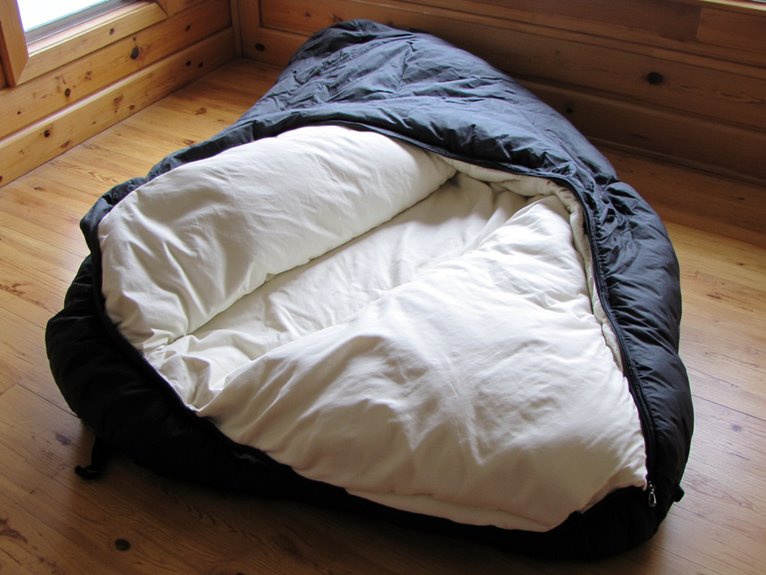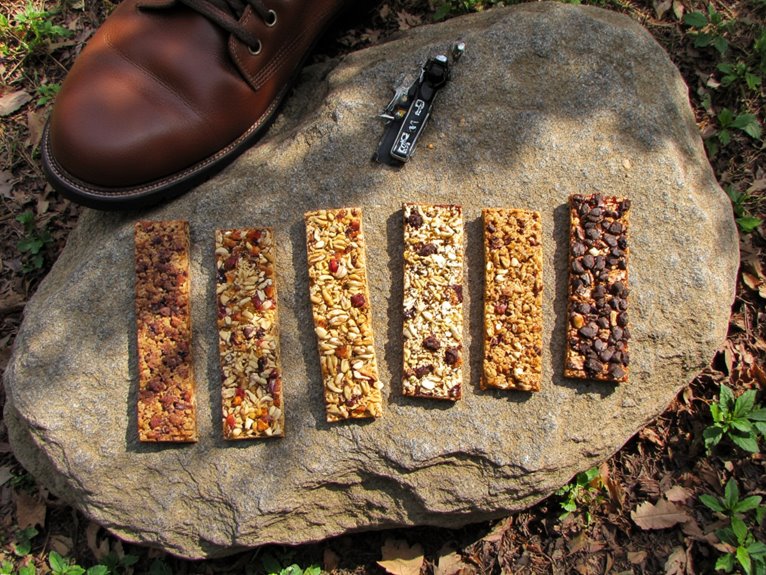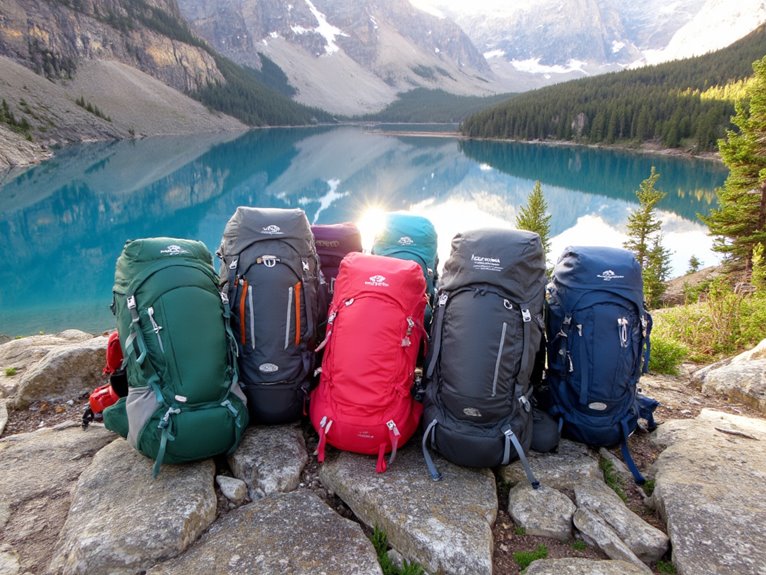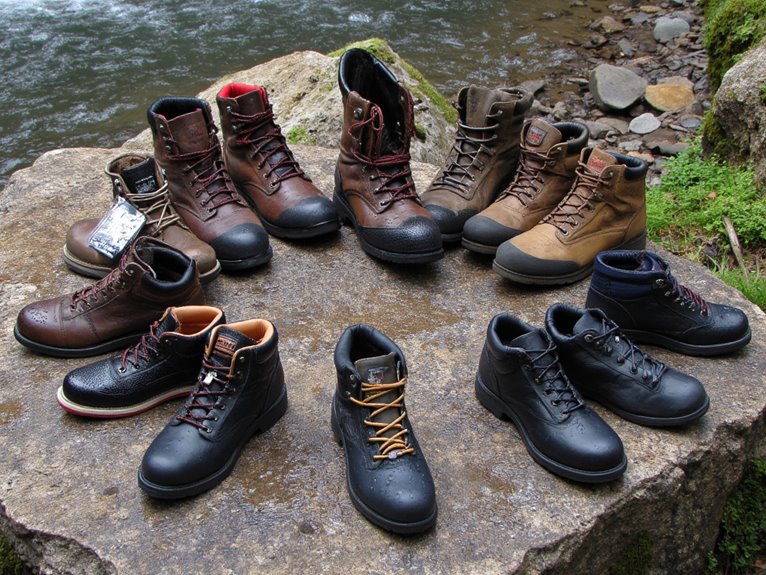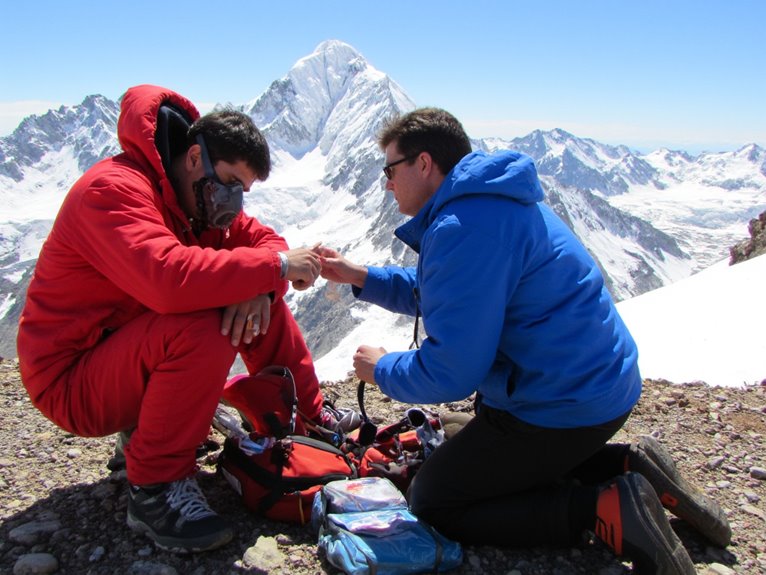What Liner for Sleeping Bag
You’ll need to match your liner material to your specific conditions: silk weighs just 5 ounces and adds 5°F warmth with exceptional packability for backpacking, cotton provides breathability for warm climates, fleece delivers 10-15°F temperature boost for cold weather but with increased bulk, synthetic blends offer moisture resistance and quick-drying properties, while merino wool excels at temperature regulation. Each material serves distinct purposes from hygiene protection to extending your sleeping bag’s lifespan by 3-5 years, and the following guide reveals ideal selections for every adventure type.
We are supported by our audience. When you purchase through links on our site, we may earn an affiliate commission, at no extra cost for you. Learn more. Last update on 10th December 2025 / Images from Amazon Product Advertising API.
Notable Insights
- Silk liners weigh 5 ounces, add 5°F warmth, pack extremely small, and work best for ultralight backpacking in warm climates.
- Fleece liners provide maximum warmth boost of 10-15°F but are bulkier and heavier, making them ideal for cold weather camping.
- Cotton liners offer breathability and durability in warm, dry conditions but lack insulation when wet and aren’t suitable for variable temperatures.
- Synthetic blend liners are lightweight, moisture-resistant, quick-drying, and versatile for different climates while combining benefits of multiple materials.
- Merino wool liners excel at temperature regulation and moisture management but require careful maintenance and aren’t as packable as silk.
Types of Sleeping Bag Liners and Their Materials
When choosing a sleeping bag liner, the material determines weight, warmth, durability, and packability for your specific use case.
You’ll find five different materials dominating the market, each with distinct performance characteristics.
Silk offers exceptional packability at 5 ounces, adding approximately 5°F of warmth while maintaining strength when wet.
Cotton provides breathability and durability but lacks insulation when moisture is present.
Fleece delivers significant warmth increases of 10-15°F, though at the cost of bulk and weight.
Synthetic blends combine lightweight construction with moisture resistance and quick-drying properties.
Merino wool excels in temperature regulation and moisture management but requires careful maintenance.
The best thickness depends on your climate conditions—silk works best in warm environments, while fleece handles cold weather applications effectively. Liners also function as sleeping bag replacements in hot climates where full sleeping bags would cause overheating. Additionally, liners promote hygiene in hostels by creating a barrier between you and frequently used bedding.
Benefits of Adding a Liner to Your Sleep System
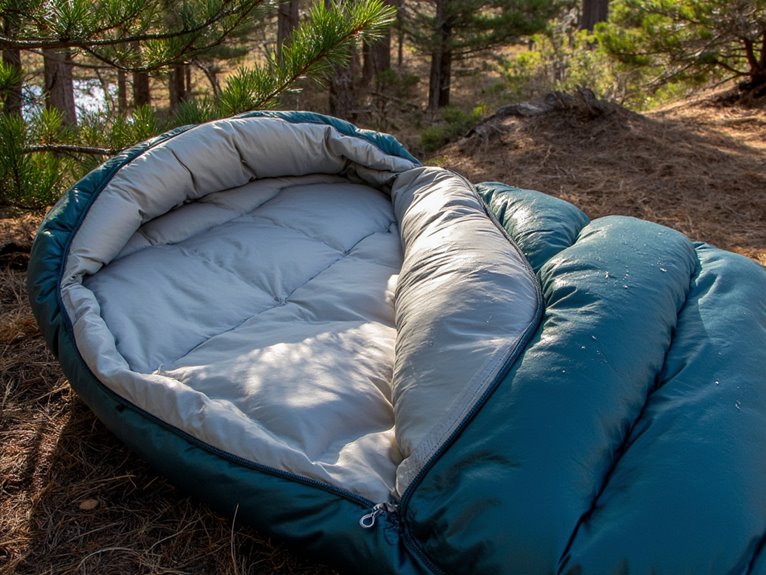
Adding a sleeping bag liner transforms your sleep system into a more hygienic, comfortable, and durable setup.
You’ll experience enhanced cleanliness as the liner creates a protective barrier that captures body oils, sweat, and dirt before they reach your sleeping bag’s fabric and insulation.
The liner also provides additional warmth through an extra insulation layer while extending your sleeping bag’s lifespan by reducing washing frequency and protecting delicate materials from contamination. In warm weather conditions, the liner can function as a standalone sheet, eliminating the need for your heavier sleeping bag entirely.
Beyond outdoor adventures, liners serve as protective layers when staying in hostels or hotels with questionable bedding quality.
For minimalist backpackers, quality liners complement ultralight sleeping pads by maintaining the sleep system’s overall weight efficiency while providing essential comfort and hygiene benefits.
Enhanced Cleanliness and Hygiene
While sleeping bags excel at insulation and warmth, they’re notoriously difficult to clean and maintain properly. A liner creates a washable barrier between your body and the sleeping bag’s interior fabric.
This simple addition delivers significant hygiene benefits by absorbing oils, sweat, and body fluids that would otherwise penetrate your sleeping bag’s fill material.
The travel convenience becomes apparent when you consider washing requirements. Liners are machine-washable and quick-drying, while sleeping bags need specialized cleaning procedures.
Your liner captures dirt, sunscreen, and insect repellent before these contaminants can clump the fill or degrade materials. In shared accommodations like hostels or shelters, liners provide essential protection against dirty mattresses and previous users’ residue.
This barrier prevents allergen exposure and microbial transmission while extending your sleeping bag’s functional lifespan. Liners also provide crucial protection against bed bugs in public accommodations where cleanliness standards may vary. Modern liners feature HEIQ Fresh treatment that actively absorbs and releases odor-causing compounds for enhanced freshness.
Added Warmth and Comfort
Beyond the hygiene benefits, sleeping bag liners deliver measurable thermal performance improvements that can transform your sleep system’s effectiveness in challenging conditions.
You’ll gain 5°F to 15°F of additional warmth depending on material choice. Fleece liners provide maximum thermal boost but add weight, while silk options offer lighter insulation with excellent breathability.
Liner versatility extends your gear’s temperature range considerably. You can use them standalone in hot weather or layer them for extreme cold. The thermal efficiency depends on your sleeping bag’s existing insulation capabilities and the liner’s thickness.
Vapor barrier liners prevent moisture loss, maintaining your sleeping temperature through reduced evaporative cooling. Synthetic materials resist water absorption while providing consistent warmth. Silk liners uniquely retain thermal insulation even when exposed to moisture, making them particularly reliable in damp conditions. Higher quality sleeping bags with better construction features will maximize your liner’s thermal performance.
This added thermal capacity transforms a three-season sleeping bag into near-winter performance.
Extended Sleeping Bag Life
Protection stands as the most valuable long-term benefit a sleeping bag liner provides for your investment.
Your sleeping bag’s insulation degrades when exposed to body oils, sweat, and dirt. Liners create a barrier that absorbs these contaminants before they reach the bag’s fill material. Down insulation particularly suffers from oil exposure, losing its loft and thermal efficiency over time.
Liner insulation protection extends your bag’s functional lifespan by 3-5 years on average. You’ll wash your sleeping bag 60% less frequently when using a liner consistently. This reduced washing frequency prevents compression damage to synthetic fills and maintains down’s natural oils. Liners are machine washable and can be cleaned frequently to maintain optimal hygiene.
Liner versatility allows use across multiple environments, from humid coastal camping to dry mountain conditions. Liners can add up to 15 degrees of warmth to sleeping bags, making them valuable additions for temperature regulation.
Cotton liners excel in warm climates, while silk variants provide superior moisture management in variable temperatures.
Silk Liners: Lightweight Performance for Backpackers
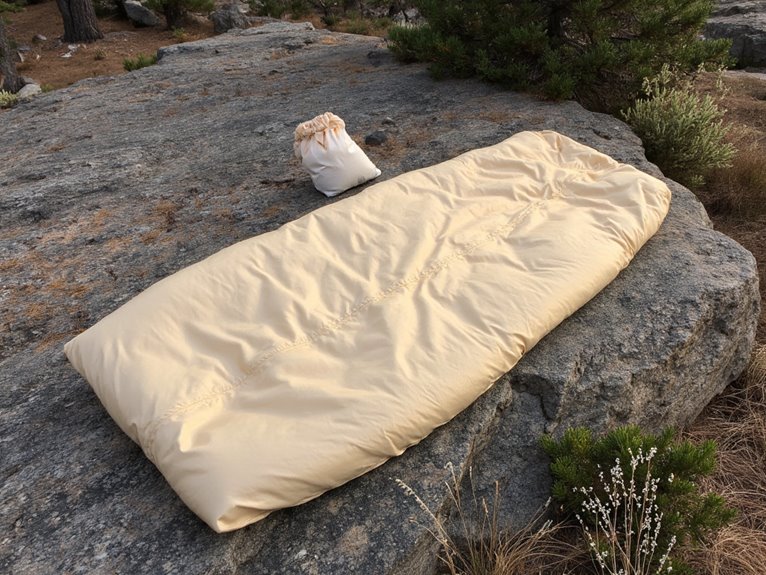
Silk liners represent the gold standard for ultralight backpacking gear, delivering exceptional performance-to-weight ratios that make them indispensable for serious hikers.
You’ll find that silk liner benefits extend far beyond simple weight savings. These liners provide superior temperature regulation, adding up to 10 degrees Fahrenheit of warmth while maintaining breathability to prevent overheating.
Your pack weight drops considerably with silk’s featherlight design. The Alpkit Mantua weighs just 108 grams—equivalent to two boiled eggs—yet packs down smaller than alternative materials.
Key performance advantages include:
- Moisture-wicking properties that prevent buildup and reduce odor retention
- Quick-drying capability for washing during extended thru-hikes
- Versatile functionality as standalone sheets in warm weather or insulating layers in cold conditions
You’ll appreciate silk’s durability in maintaining consistent thermal performance across various climates. When paired with quality sleeping pads, silk liners create an optimal sleep system that balances comfort and portability for ultralight adventures.
Cotton and Egyptian Cotton Options for Comfort
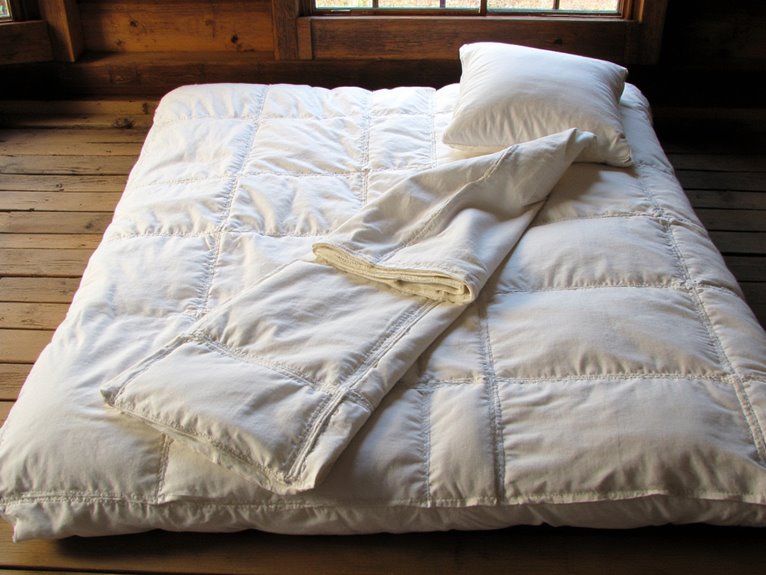
Cotton liners deliver unmatched sleeping comfort through their soft, natural texture that mimics familiar bed linens.
You’ll appreciate their breathable design that prevents overheating during warm weather camping or indoor hostel stays.
Standard cotton liners add moderate warmth while absorbing moisture effectively, though they retain dampness longer than synthetic alternatives.
Egyptian cotton elevates this egyptian comfort with finer fibers that reduce weight while maintaining superior softness.
These premium liners add approximately 7.2°F of warmth, with silk-blended versions increasing temperature ratings by 8.6°F.
Cotton versatility shines in travel scenarios where hygiene matters more than ultralight requirements.
However, cotton’s bulk and slower drying time make it less suitable for wet conditions or weight-critical backpacking.
You’ll find cotton liners excel in hostels, huts, and car camping where comfort outweighs portability concerns.
Fleece Liners for Maximum Warmth in Cold Conditions
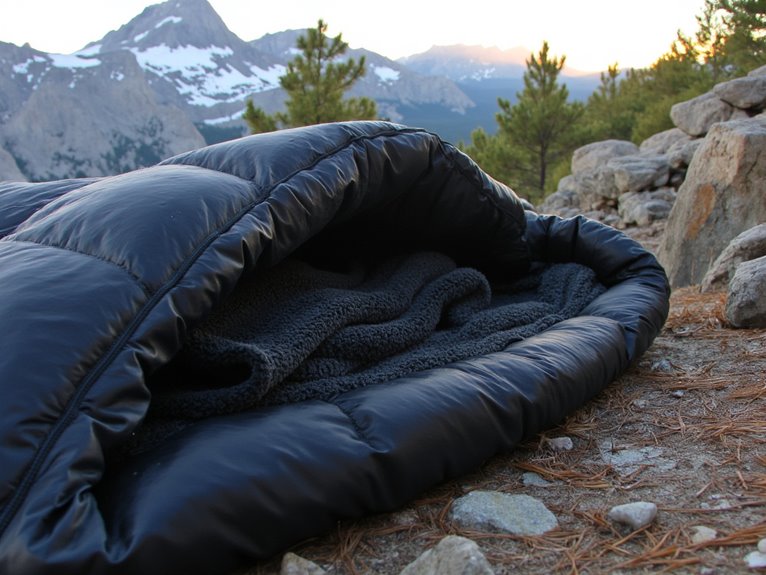
When temperatures drop considerably, fleece liners become your most effective option for adding substantial warmth to any sleeping bag system.
These liners use advanced hollow-core Thermolite® Pro fibers arranged in grid patterns that trap air pockets, boosting your bag’s thermal rating by approximately one full season.
You’ll find fleece liners particularly valuable in cold weather conditions where traditional cotton or silk options simply can’t provide the insulation needed for comfortable sleep.
For extreme cold conditions, pairing fleece liners with 0-degree sleeping bags creates a winter system capable of maintaining warmth even when temperatures plummet well below freezing.
Fleece Warmth Performance
How much additional warmth can fleece liners actually deliver when you’re facing genuinely cold conditions? Manufacturers claim temperature improvements up to 25°F, but field testing reveals more realistic gains of 10°F for quality fleece models.
Sea to Summit data shows their fleece insulation increases a 3-season bag’s rating by 6%.
The hollow-core Thermolite® Pro fibers in premium liners trap air efficiently, creating superior thermal barriers.
Grid-pattern construction enhances this effect by forming air pockets that minimize convection heat loss.
Your sleeping experience improves most dramatically with lighter base bags, where fleece liners deliver maximum thermal benefit.
- Air pockets forming microscopic thermal chambers throughout the fabric
- Hollow fibers creating invisible tubes that capture and hold warm air
- Grid patterns weaving together like thermal mesh across your body
Cold Weather Suitability
Fleece liners excel in genuinely cold conditions where every degree of warmth retention becomes critical for safety and comfort.
The hollow-core Thermolite® Pro fibers deliver exceptional thermal boost through strategic air pocket creation. These fibers trap warm air within their hollow construction, considerably enhancing your sleeping bag’s insulation properties.
You’ll benefit from the technical hood design with drawcord closure, which prevents heat loss from your head—a major thermal vulnerability during sleep.
The shaped footbox maintains warmth around your feet while offering ventilation control.
The Reactor Fleece Liner effectively adds an entire season of warmth to your existing sleep system.
Combined with proper sleeping mats, it creates thorough thermal protection.
Shoulder zippers and drawcord features allow precise temperature regulation throughout the night.
Synthetic Liners for Moisture Management

Most synthetic sleeping bag liners excel at moisture management through specialized fiber technology that actively transports perspiration away from your skin.
Coolmax fibers create superior moisture evaporation by wicking sweat to the fabric surface where it can evaporate quickly. This process maintains a dry microclimate around your body during humid nights.
Modern synthetic blends combine 70% Coolmax with 30% Tencel Lyocell for enhanced breathability features and softness.
These materials prevent moisture accumulation inside your sleeping bag, preserving insulation loft and preventing clumping from oils and sweat.
- Coolmax fibers rapidly transport perspiration from skin to fabric surface
- Tencel Lyocell blend creates soft, breathable sleep environment
- Quick-drying synthetic materials resist mildew formation
Technical liners incorporate HEIQ Fresh bio-based odor control technology that absorbs compounds during use and releases them when washed.
Mummy Vs Rectangular Shapes: Choosing the Right Fit
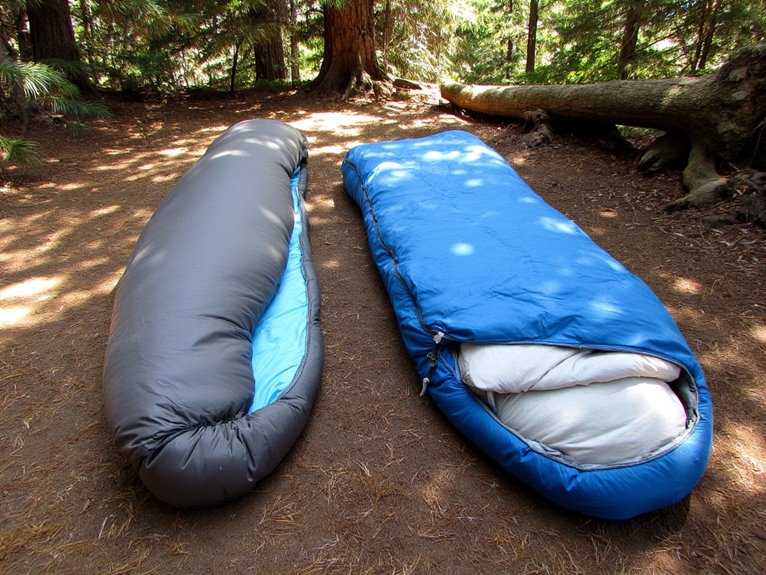
After selecting the ideal moisture-wicking material, you’ll need to match your liner’s shape to your sleeping bag design for peak performance. The mummy design follows your bag’s contours precisely, offering superior thermal efficiency through reduced air gaps. These liners weigh approximately 4.6 oz and pack smaller due to less fabric. A rectangular fit provides maximum mobility but sacrifices some warmth retention.
| Feature | Mummy Design | Rectangular Fit |
|---|---|---|
| Weight | 4.6 oz | 6-8 oz |
| Thermal Efficiency | Superior | Moderate |
| Versatility | Backpacking only | Multiple uses |
Choose mummy liners for cold-weather backpacking where weight matters. Select rectangular options for hostel stays or when comfort trumps thermal performance. The shape compatibility directly affects your system’s overall effectiveness. For optimal warmth, consider selecting a liner that complements bags with temperature ratings 10-15 degrees lower than expected conditions to maintain comfort throughout the night.
Selecting the Best Liner for Your Adventure Type
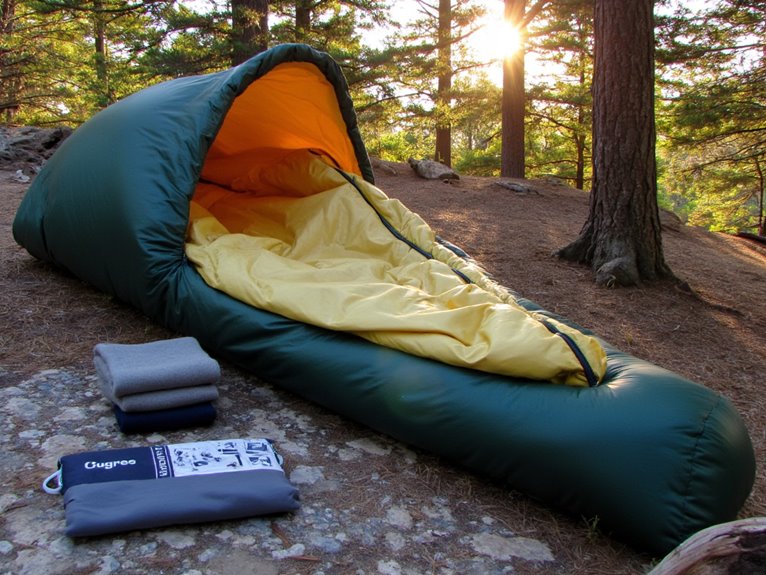
Which adventure you’re planning determines your liner requirements more than any other factor. Backpacking demands lightweight silk or stretch-knit materials for maximum packability.
Winter expeditions require non-breathable vapor barrier liners that trap body heat in extreme cold. Hostel travel calls for cotton liners prioritizing hygiene and easy washing over weight savings.
Weather specific considerations drive material selection. Humid conditions need moisture-wicking synthetics, while cold environments benefit from Thermolite thermal boost technology.
Midge-prone areas require silk’s natural insect protection properties.
Liner customization options include:
- Footbox drawcords for temperature regulation and mobility
- Stretch panels providing enhanced comfort during sleep movement
- Hooded designs offering complete vapor barrier protection systems
Match your liner’s technical specifications to your adventure’s environmental demands. Temperature ratings, material properties, and weight specifications determine field performance more than comfort preferences. Choose temperature ratings that are 10-15°F below expected conditions to ensure your liner complements your sleeping bag’s thermal performance effectively.
Care and Maintenance Tips for Liner Longevity
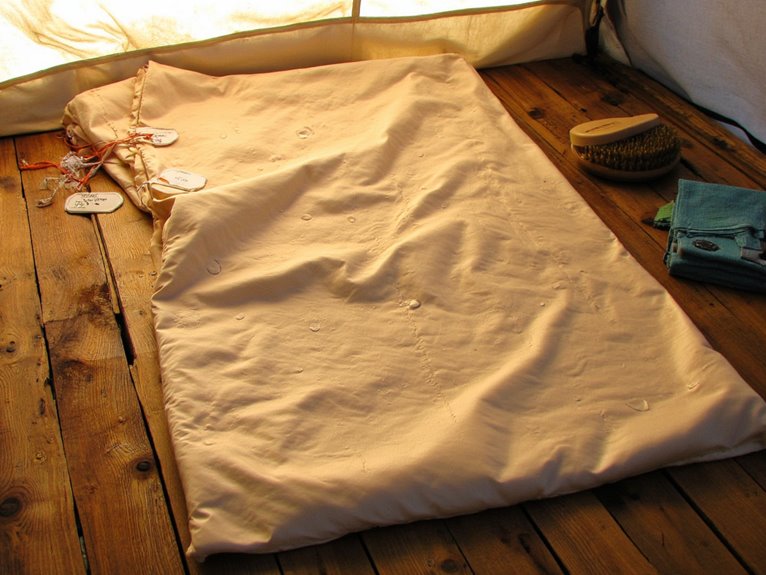
Proper liner care extends service life from seasonal use to years of reliable performance.
Essential maintenance techniques begin with reading manufacturer labels for specific washing guidelines. Use cold water and mild detergent for most materials. Cotton and polyester liners handle machine washing well, while silk requires gentle hand washing. Never use fabric softeners—they compromise wicking abilities that keep you dry.
Effective longevity strategies include air drying to prevent heat damage. Roll liners gently to remove excess water without twisting. Store in clean, dry environments away from direct sunlight to prevent material degradation. Use mesh bags during machine washing to protect against snags.
Only wash when necessary to maintain material integrity. Regular inspections help identify wear before it compromises performance.
Frequently Asked Questions
Can I Use a Sleeping Bag Liner Without a Sleeping Bag?
You can absolutely use a sleeping bag liner without a sleeping bag.
Liners work excellently as standalone bedding in warm climates, hostels, or tropical travel.
Choose silk or bamboo materials for hot weather applications.
However, liners lack the temperature ratings of proper sleeping bag types and provide minimal insulation.
They’re perfect for temperatures above 65°F but won’t protect you in cold conditions where insulated sleeping bags are necessary.
How Much Does a Sleeping Bag Liner Typically Cost?
You’ll find sleeping bag prices for liners range from $20 to $199, depending on liner materials and features.
Budget polyester or cotton options cost $12-$40, while premium silk liners run $90-$100+.
Mid-range synthetic materials like Thermolite cost $64-$110.
Popular brands like Sea to Summit offer entry-level models at $39.95, with premium versions reaching $109.95.
Expect to pay more for ultralight fabrics, insect protection, or specialized insulation features.
Do Sleeping Bag Liners Come With Warranties or Guarantees?
Sleeping bag liners rarely come with extensive warranty coverage like their full sleeping bag counterparts.
Most manufacturers don’t offer specific product guarantees for liners due to their lightweight construction and lower price point.
You’ll typically find limited coverage against manufacturing defects only, excluding normal wear and tear.
Some premium brands like Sea to Summit may provide defect warranties, but you’ll need proof of purchase from authorized dealers for any claims.
Can I Attach My Liner Permanently to My Sleeping Bag?
You shouldn’t attempt permanent attachment of your liner to your sleeping bag. This practice eliminates the liner’s primary advantage of easy removal for washing and maintenance.
Permanent attachment creates cleaning difficulties since sleeping bags require less frequent washing than liners. Most manufacturers design liners with temporary attachment methods like drawstrings or clips to guarantee liner compatibility across different bag sizes while maintaining modularity for ideal hygiene management.
What’s the Smallest Packed Size Available for Lightweight Liners?
The smallest packed size you’ll find is the Western Mountaineering Tioga at 2.25 x 4 inches, weighing just 3.6 oz.
Lightweight materials like silk create these compact designs. The Cocoon Silk Mummy follows at 5.7 x 2.4 inches and 4.4 oz.
Both use 100% silk for maximum compression.
Synthetic options like the Sea to Summit Reactor pack larger at 5.9 x 2.8 x 4.3 inches despite their thermal benefits.
On a final note
You’ll extend your sleeping bag’s lifespan and improve comfort by choosing the right liner. Match material to conditions: silk for weight savings, cotton for comfort, fleece for cold weather, and synthetics for moisture control. Consider your bag’s shape when selecting mummy or rectangular designs. Proper care maintains performance for years. Don’t overlook this simple upgrade—it’s one of the most cost-effective improvements you can make to your sleep system.

